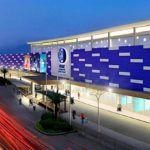
A livable metropolis
By Boo Chanco (The Philippine Star)
Updated November 3, 2017 – 12:00am
http://www.philstar.com/
Except for the rainy weather, Metro Manila has shown itself to be a rather livable metropolis over the past week. I don’t know how many residents left the metro area for their provinces or for foreign vacation spots. But perhaps more than half of the metro population stayed off the streets and it was just great.
The traffic started getting light last Monday, making a drive to Makati fast and pleasant. I didn’t have to agonize whether to choose C-5 or EDSA because traffic flowed smoothly in both main avenues. If only it could be like this all the time…
The dream ends on Monday. The horde of humanity that momentarily left will be back by then. Our pleasant experience this week goes to show we really have to encourage more people, more businesses to move out of Metro Manila. With today’s technology, it shouldn’t be that difficult to do business from anywhere.
Transport Secretary Art Tugade was right in his initial observation that Metro Manila is just too overcrowded and made unbearable by a sadly inadequate transport infrastructure. In our conversations before he took office, Sec. Tugade proposed pulling out PEZA incentives for BPOs in Metro Manila and moving them to Clark or nearby provinces.
I heard Malacañang has been stingy in signing off on those PEZA incentives proposed by a very active property sector. I thought this was because the Duterte administration has adopted a new policy proposed by Sec. Tugade. But a few permits are given now and then, so maybe there are other reasons.
In the meantime, Pagcor has approved close to 50 permits for offshore gambling operations to establish their bases in Metro Manila. The entities known as the Philippine Offshore Gaming Operations (POGO) are reportedly pricing out regular BPOs by offering cash payments of rentals in advance.
I am not sure how good these POGO businesses are for the country. They bring in their own employees who speak Mandarin or whatever language the target market speaks. I suppose they also displace local BPO employees from affordable housing rentals.
In the past, POGO operations were kept within the Cagayan EPZA and at Clark. That P50 million bribery case involving two immigration officials had to do with the illegal entry of foreign workers. The POGO operator wanted the Bureau of Immigration to release the arrested workers from Clark.
I realize that moving enough people out of Metro Manila to make the city livable is not easy. The mistake of concentrating economic and political activities in Metro Manila will take years to correct. The only one in government who seems to believe enough in decongesting Metro Manila is Sec. Tugade, who moved the headquarters of DOTr to Clark.
A friend of mine who runs a BPO operation has been complaining about losing staff because they can’t get to the office on time. Worse, they are being replaced by foreign students who have enough resources to live around Makati and take on part time jobs in BPOs for extra income.
That’s why building transport infrastructure is as urgent as urgent can be. Decongesting Metro Manila would help, but shouldn’t be our main effort. Fixing MRT3, extending LRT1 and 2 and introducing BRT lines should be the focus of attention. With good mass transport, workers can live in surrounding provinces and still work in Makati, Ortigas or BGC.
For that to happen, we must have a DOTr leadership and staff not prone to excuses for any inability to move faster on the Duterte administration’s Build Build Build program. The fact that the economic managers of Duterte chose to fund infra from the national budget instead of PPP means the pressure is totally on them to perform.
But as I have often pointed out in this column, DOTr and DPWH do not have the bureaucracy that can carry out the ambitious infra program. Just in the conduct of feasibility studies, they already have problems.
This why the ADB proudly announced they are giving our government a $100 million loan to improve the capability of the infra agencies to carry out their mandates. But the same press release talks of building capability to prepare big ticket projects through 2022.
It seems ADB is only trying to create a market for foreign engineering and consulting firms to do the feasibility studies for projects that won’t see the light of day within the regular term of Mr. Duterte. The ADB loan, not grant, will not help DOTr speed up implementation of the transport infra projects we are so anxious to see.
Sometimes, I am not sure our officials know what they are doing. During the Aviation Day conference last week, Ed Monreal, NAIA GM made a statement that is so wrong. He said a government managed airport is better because the costs to the airlines and passengers would be cheaper.
Yet, I understand, Monreal has made a proposal to privatize the maintenance of the air conditioning system of the terminals. Monreal made the proposal after he found it difficult to procure needed spare parts under government procurement rules. As a result, the pre-departure area of Terminal 3 lacks adequate cooling.
Assuming, but not conceding that the private sector will charge more in terms of landing and other fees, we can expect a well managed private sector led airport to save us waiting time. Time, after all, is money. And government has taken us for granted in that count.
I really am very anxious to see Megawide complete its new terminal building in Mactan and show our bureaucrats how to run an airport. Even now, with the old terminal, Megawide has introduced enough changes to make passenger flow and availability of services better.
It is unfortunate that government has taken the airline industry for granted. It is the only major industry that has taken government’s rosy economic projections seriously by investing heavily in new aircraft. Yet, Mar Roxas even castigated the airlines for causing congestion at NAIA. Monreal did the same thing when he urged the carriers to seek their approval before buying new planes.
Government is also less than supportive when the local airlines open new routes in response to market demand. A proposed new route from Zamboanga to Sandakan was scrapped because the immigration people in Zamboanga were not willing to take the extra load.
As Cebu Pacific president Lance Gokongwei said during last week’s conference, the growth of the aviation industry would only be as robust as the existing infrastructure can support. “It is imperative that the private and public sectors come together so that airport capacity and air traffic infrastructure are aligned with projected demand.
“Alongside infrastructure, government agencies which provide support functions such as border control and security must be ready to support the growth in aviation, especially in new international routes. Infrastructure must be coupled with streamlined processes to make air travel more efficient. Automation, data collaboration, and process reviews are necessary to move a growing number of travelers more expediently.”
Going back to the hellhole that is Metro Manila… there are more no-work days this month for ASEAN. Maybe those who left this week will leave again if only to avoid the mess on EDSA as they secure the roads from NLEX to MOA. I guess we should be happy with every little thing we get that offers us relief, no matter how momentary.










